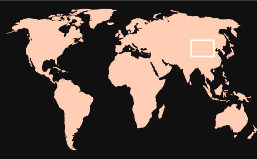|
|
Geography Wedged between Russia to the north and China to the
south, Mongolia
is the world's largest landlocked country. This
area is the eastern terminus of the great Eurasian Steppe, which stretches
across Central Asia all the way to Hungary. Most
of the country is unsuitable for settled agriculture, but ideal for grazing
livestock on a seasonal basis. These
three facts are overwhelmingly important to the country’s history, culture
and economy. Wedged between Russia to the north and China to the
south, Mongolia
is the world's largest landlocked country. This
area is the eastern terminus of the great Eurasian Steppe, which stretches
across Central Asia all the way to Hungary. Most
of the country is unsuitable for settled agriculture, but ideal for grazing
livestock on a seasonal basis. These
three facts are overwhelmingly important to the country’s history, culture
and economy. HistoryNomadic Pastoralism, the technical term for moving around with livestock as a way to make a living, was developed in Central Asia in the last two millennia. It resulted directly in a self-sufficient, highly mobile populace skilled in hunting – a potentially dominant military force needing only a leader. Genghis Khan, meaning 'Universal King', was so appointed in 1189 at the tender age of 27. He had unified the fiercely independent Mongol tribes and would go on to conquer most of the Eurasian landmass with his ready-made army, forming the largest empire the world has ever known.
 In the 17th century the Chinese finally took control of
the troublesome region, and held it until 1911. After
ousting the Chinese, Mongolia became the world’s second Communist nation
in 1924, and remained securely in the Soviet orb until the breakup of that
empire.
In the 17th century the Chinese finally took control of
the troublesome region, and held it until 1911. After
ousting the Chinese, Mongolia became the world’s second Communist nation
in 1924, and remained securely in the Soviet orb until the breakup of that
empire.PeoplePopulation of 3 million, or just 5 people per square mile. Khalk Mongols make up over 90% of the population, a percentage which is increasing as the largest minority group, Kazakhs, are choosing to return to their motherland. Tibetan Buddhism is the predominant faith, with Shamanism, an early form of nature worship, also playing an important role. As Buddhism is not an exclusive faith like Christianity, Judaism or Islam, most Mongolians have no trouble reconciling their twin belief systems.The Mongolian language is a member of the Ural-Altaic family of languages, which includes the likes of Finnish, Uzbek and Korean. The script is Cyrillic, courtesy of the Soviets. In other words, it’s not easy to pick up. The UN ranks Mongolia in the 34th percentile in terms of quality of life, based on life expectancy, education and income; this is below most Asian countries. The majority of Mongolians are still nomadic herders who live in felt tents (gers, pronounced 'gairs') and are outnumbered by livestock 16:1. This has contributed to making them among the world’s most hospitable, proud and likeable residents, and prodigious consumers of meat and dairy products.EconomyMongolia is poor in monetary terms, having a GNP per capita of $380 per year. However, the substantial self-sufficiency of the average Mongolian means the non-monetary economy is even more important. The truly destitute are rare, though their numbers are increasing.Reforms of the Socialist system are underway, but less is required than in other countries (e.g. Russia or China) because the new ways never really displaced nomadic pastoralism. Mongolia currently exploits very few natural resources (other than grass): copper and cashmere are the leaders. There may be commercially attractive oil and coal deposits. Sources: World Bank (1998 data), Dorling Kindersley World Reference Atlas, UNDP Human Development Report, Lonely Planet
|